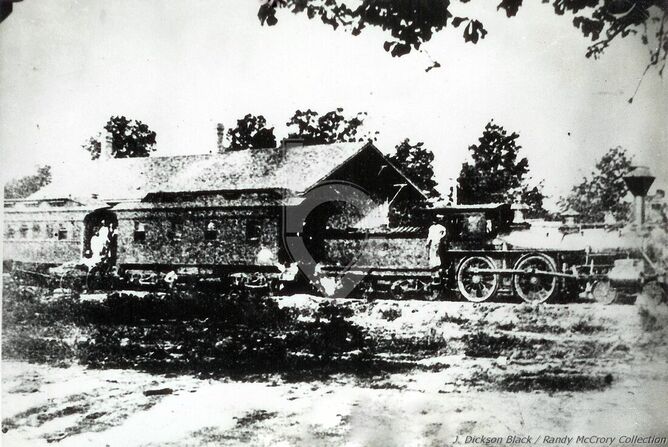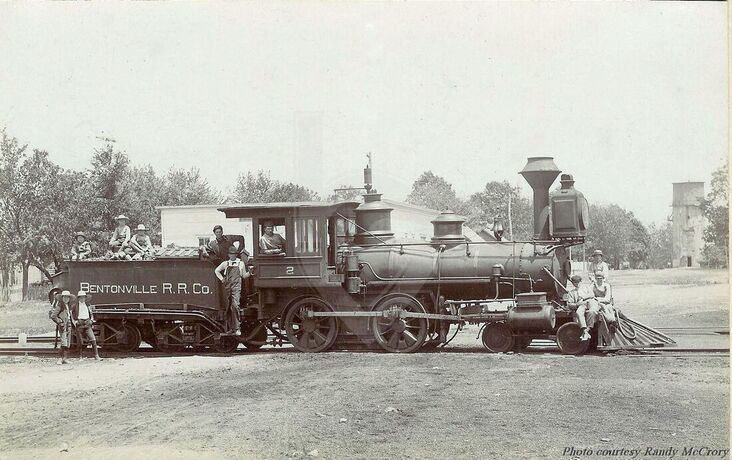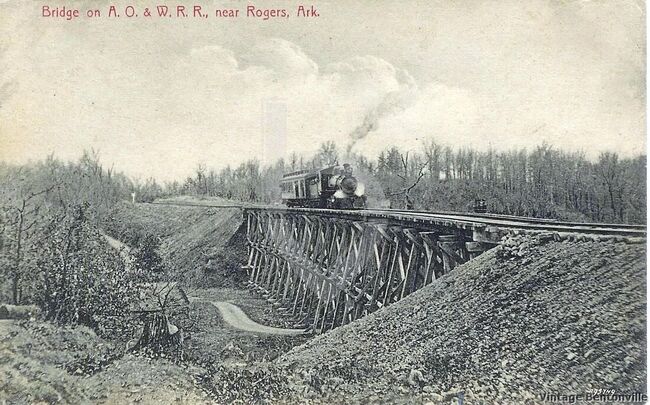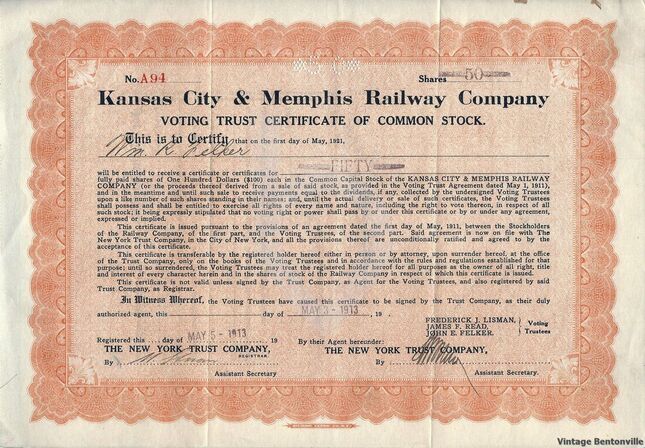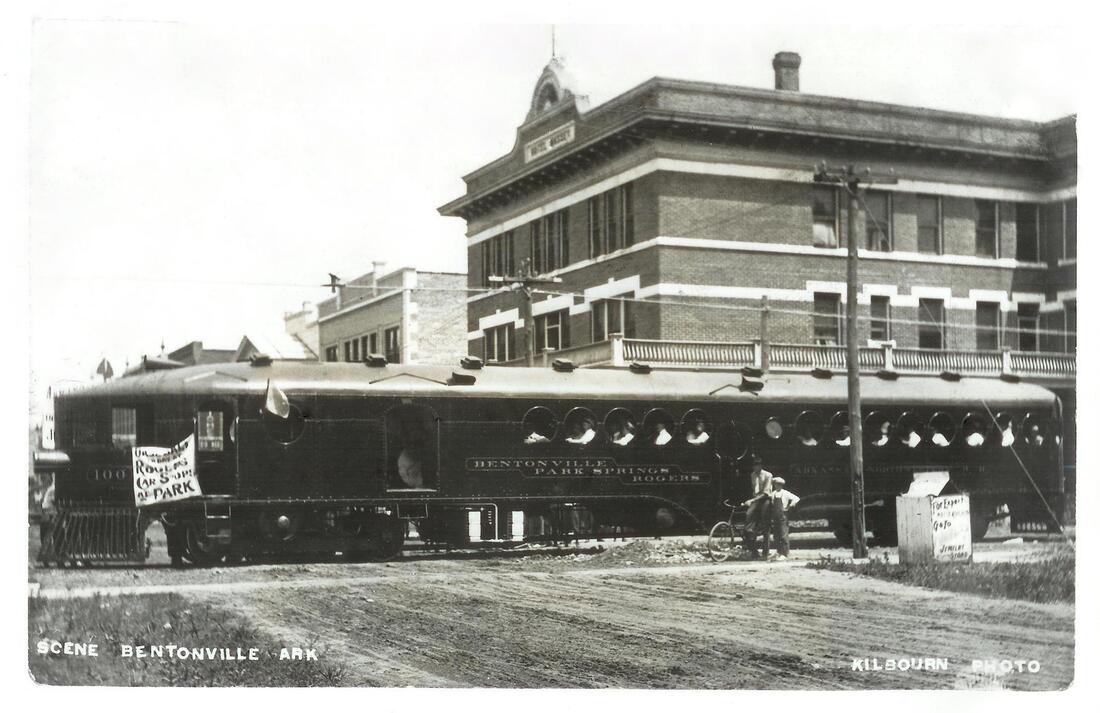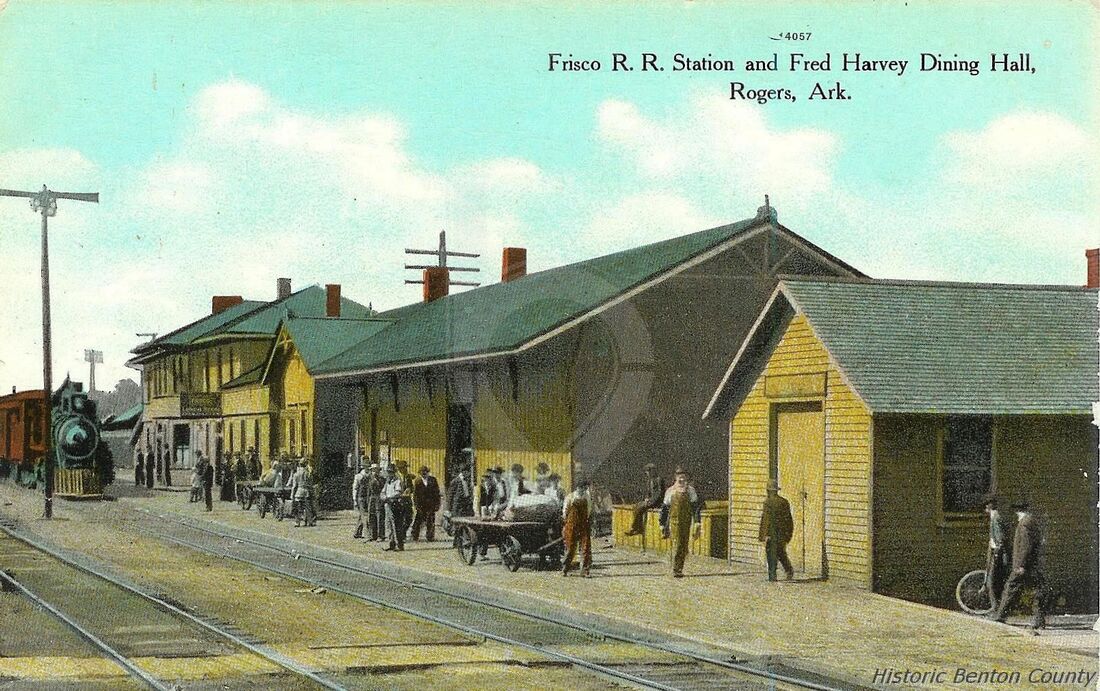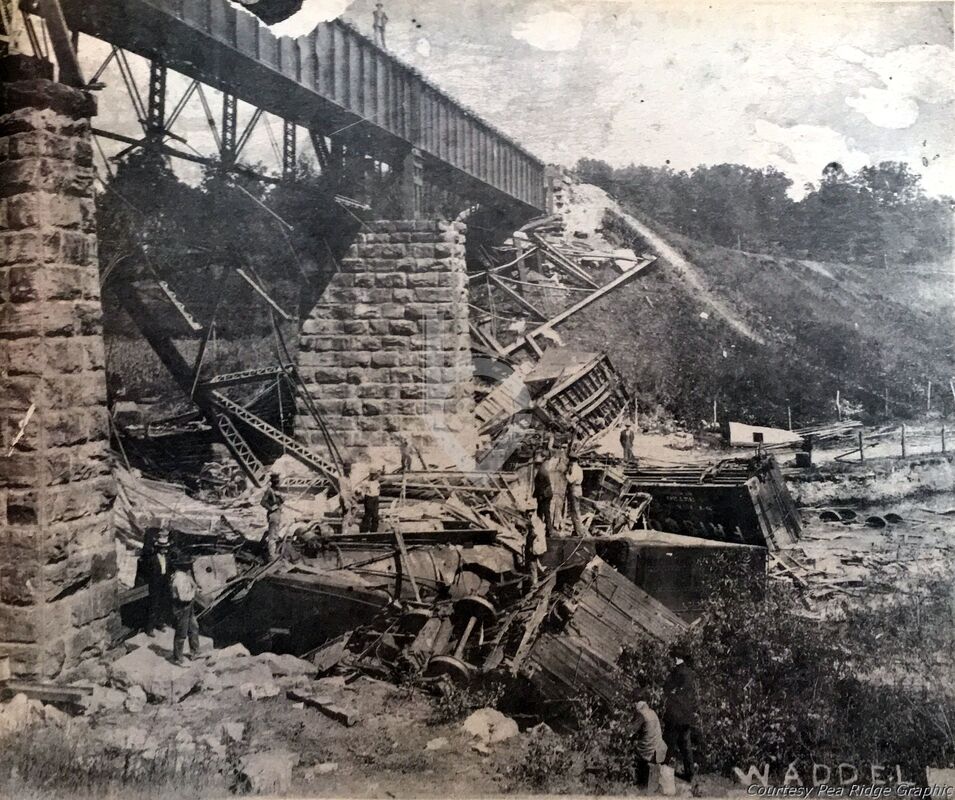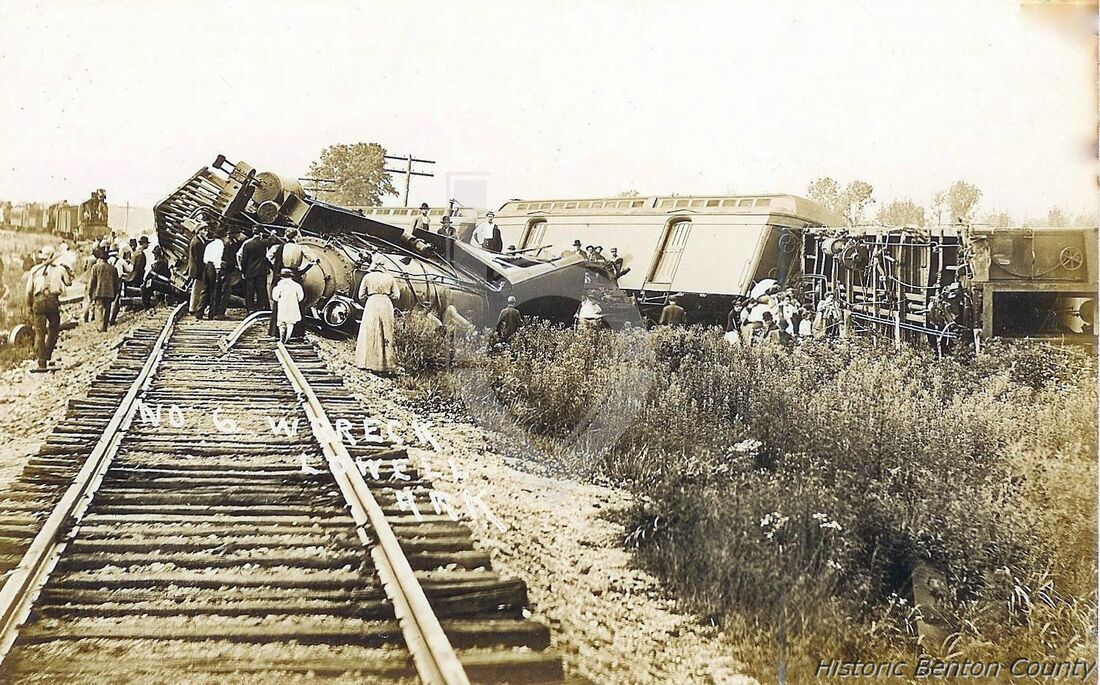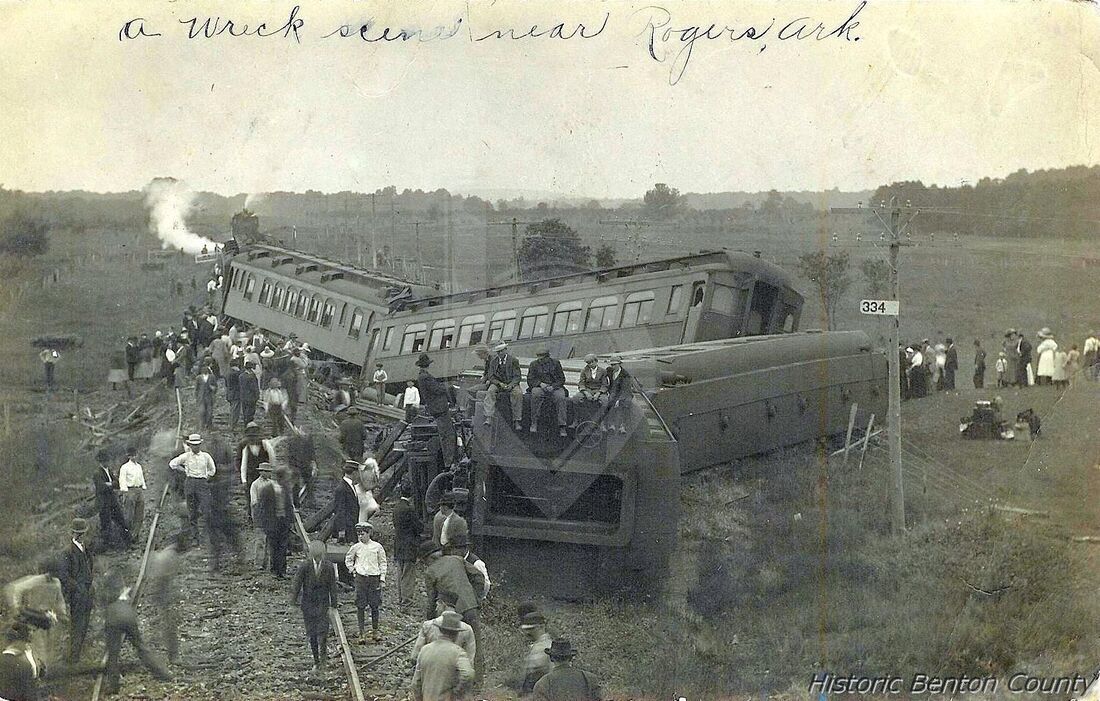History of Railroads in Benton County
From the Rogers Daily News July 1, 1950 (now the NWADG)
From the Rogers Daily News July 1, 1950 (now the NWADG)
Not so many years ago an old newspaper clipping was found that gave some interesting facts regarding what may be accepted as the first railroad rumor in Benton county. Back in 1860, the levying court of Benton county voted an appropriation of $500 to assist in the preliminary survey for a railroad to run from Van Buren, in Crawford county, to some point on the Missouri Pacific railroad in Missouri. C. W. Rice, Sr., was selected as Benton county representative and it was specified the road was to cross Crawford , Washington and Benton counties. It came to naught, however, because of the Civil War and the money was returned to the treasurer.
It was more than twenty years later before Benton county finally got a railroad - and then with no help from the county.
Probably a search of Frisco records show when the first preliminary survey was made for routes through Benton county but they never have been given newspaper publicity and are not available. No one has ever found a date as to just when the Frisco company decided to locate a town at this site [Rogers], but with Bentonville just seven miles from its line, it was logical that a town be located somewhere within easy trading and freighting distance of the county seat.
May 10, 1881, was the day the first passenger train arrived in Rogers and that day has always been observed as the anniversary day for celebrations, despite the fact that it was incorporated under the laws of Arkansas May 28, 1881.
It was more than twenty years later before Benton county finally got a railroad - and then with no help from the county.
Probably a search of Frisco records show when the first preliminary survey was made for routes through Benton county but they never have been given newspaper publicity and are not available. No one has ever found a date as to just when the Frisco company decided to locate a town at this site [Rogers], but with Bentonville just seven miles from its line, it was logical that a town be located somewhere within easy trading and freighting distance of the county seat.
May 10, 1881, was the day the first passenger train arrived in Rogers and that day has always been observed as the anniversary day for celebrations, despite the fact that it was incorporated under the laws of Arkansas May 28, 1881.
A history-making train - It was the arrival of the above Frisco passenger train on May 10, 1881, that gave Rogers a birthday.
Old No. 17 was the first to run over new tracks into Rogers. The town began with that trip.
Old No. 17 was the first to run over new tracks into Rogers. The town began with that trip.
In 1887 Rogers citizens subscribed a $20,000 bonus for an east and west railroad to be built from Harrison west through Rogers and Bentonville and then northwest to connect with the Pittsburg & Gulf railroad at McElhaney, Mo. An effort was made to transfer this bonus to the proposed Arkansas & Oklahoma railway from from Rogers to Gravette but the subscribers refused to accept any change in the proposed route and the scheme fell by the wayside.
Arkansas & Oklahoma Railroad
No dates are available as to when the first railroad was built by private parties, connecting Rogers and Bentonville. But it was in the early [18]80's and while it was never much of a road so far as equipment was concerned it served as a connecting link and was a great convenience for the for the people of both towns.
At a public meeting in Rogers April 7th, 1898, the promoters of a proposed railroad from Rogers to Gravette, to connect with the Pittsburg & Gulf (later the Kansas City Southern) explained their plans and asked for a local bonus of $20,000. There was some opposition, but the amount was pledged and the event celebrated with a free lunch, a brass band, bonfires, speeches, etc. How much of that $20,000 was ever collected the records do not show.
At a public meeting in Rogers April 7th, 1898, the promoters of a proposed railroad from Rogers to Gravette, to connect with the Pittsburg & Gulf (later the Kansas City Southern) explained their plans and asked for a local bonus of $20,000. There was some opposition, but the amount was pledged and the event celebrated with a free lunch, a brass band, bonfires, speeches, etc. How much of that $20,000 was ever collected the records do not show.
The Arkansas & Oklahoma Rail was originally called the the Bentonville Railroad Company. By the time this photo was taken the name had been changed to the Arkansas & Oklahoma Railroad. Included in this July 1902 photo is M. F. Hendrick, engineer. The photo was taken in Rogers, Arkansas, in the middle of Walnut St. Notice the old Rogers water tower in the background on the right.
When the Arkansas & Oklahoma Railway company was incorporated in May, 1898, for $200,000 the names on the incorporation papers were John M. Bayless, E. J. Glascow, W. A. Miller, T. Mallen, W. K. Bayliss, W. R. Felker, J. A. Rice and D. H. Woods. They secured control of the old railroad between Rogers and Bentonville, relaid the steel, bought new equipment, and completed the extension to Gravette in the fall of 1898. The following year the road was extended to Grove, Okla. Bayliss and Felker were the real stockholders of the company and their names are the only ones mentioned when the road was sold to the Frisco in November, 1900.
Felker Builds Another Railroad
It was February, 1904, that the first publicity was given the proposed Rogers Southwestern railway, to connect with the Kansas City Southern at either Gentry or Siloam Springs. W. R. Felker of Rogers was the chief promoter of the proposed new Rogers railroad outlet.
In the summer of 1904, the Rogers city council granted a 50-year franchise to the Rogers Southwestern, giving it right-of-way up First street from the south edge of town to Cherry street and then through the alley between First and Second streets to Elm. Details are to be found in Ordinance No. 22
Work on the new road began November , 1905, after several months of surveying. Ten graders were on the job under the supervision of J. H. G. Brown of Gravette with Ned Whitcomb doing the surveying and establishing grades. Grading began in the McGaughey addition on the west side of the Frisco tracks, west of the fair grounds. The new road paralleled the Frisco track for about a mile below the street crossing at the home of Dr. W. J. Curry. [The 1919 city directory gives the address as 106 E. Sycamore.]
Track laying began April 18, 1906, with the arrival of the first car of steel at Rogers. By the first of September, the track had reached Springtown and it celebrated the arrival of the first passenger train September 4 with a picnic dinner, band concert, ball game, speeches, and the usual trimmings. It was at this celebration W. R. Felker announced that the road would continue to Siloam Springs.
Checking the steps of this road is a little confusing because of the changes of name. Incorporated first as the Rogers Southwestern one finds it being taken over by a new company, the Arkansas, Oklahoma and Western Railroad company on February 13, 1907. Officers: W. R. Felker, president; Alf Williams, vice president; J. E. Felker, treasurer; F. F. Freeman, secretary. The new company, known locally as the A. O. & W., was granted a charter to build and operate a standard gauge railroad from Rogers east to Eureka Springs, and from Rogers west through Siloam Springs, to Pryor Creek, I. T. Capital stock $3,000,000. Later it became the Kansas City & Memphis.
In the summer of 1904, the Rogers city council granted a 50-year franchise to the Rogers Southwestern, giving it right-of-way up First street from the south edge of town to Cherry street and then through the alley between First and Second streets to Elm. Details are to be found in Ordinance No. 22
Work on the new road began November , 1905, after several months of surveying. Ten graders were on the job under the supervision of J. H. G. Brown of Gravette with Ned Whitcomb doing the surveying and establishing grades. Grading began in the McGaughey addition on the west side of the Frisco tracks, west of the fair grounds. The new road paralleled the Frisco track for about a mile below the street crossing at the home of Dr. W. J. Curry. [The 1919 city directory gives the address as 106 E. Sycamore.]
Track laying began April 18, 1906, with the arrival of the first car of steel at Rogers. By the first of September, the track had reached Springtown and it celebrated the arrival of the first passenger train September 4 with a picnic dinner, band concert, ball game, speeches, and the usual trimmings. It was at this celebration W. R. Felker announced that the road would continue to Siloam Springs.
Checking the steps of this road is a little confusing because of the changes of name. Incorporated first as the Rogers Southwestern one finds it being taken over by a new company, the Arkansas, Oklahoma and Western Railroad company on February 13, 1907. Officers: W. R. Felker, president; Alf Williams, vice president; J. E. Felker, treasurer; F. F. Freeman, secretary. The new company, known locally as the A. O. & W., was granted a charter to build and operate a standard gauge railroad from Rogers east to Eureka Springs, and from Rogers west through Siloam Springs, to Pryor Creek, I. T. Capital stock $3,000,000. Later it became the Kansas City & Memphis.
Image shows an Arkansas, Oklahoma & Western railroad train on one of the numerous wood trestles between Rogers and Siloam Springs. The train usually consisted of a locomotive and a single passenger car.
The date when the first passenger train reached Siloam Springs is not available but there was another celebration with a big crowd of Rogers people being present.
Around the first of December 1909, Senator F. F. Freeman bought the Monte Ne railroad from W. H. Harvey, which was built from Lowell to Monte Ne in 1902. Mr. Freeman, a son-in-law of W. R. Felker, owned the Rogers White Lime Company located on the railroad just east of Cross Hollows, and was its main shipper. Inasmuch as Mr. Freeman was an officer of the A. O. & W., it was assumed that the purchase was made with the intent of connecting the two roads.
Work of building a connecting link began that winter but it was some time before one could travel by rail from Rogers to Monte Ne. It was necessary to build an underpass to get across the Frisco tracks and it proved to be a long and expensive job. The Frisco attempted to block the work through the courts but finally an agreement was made out of court and the underpass completed. The old cut and underpass is still in evidence south of Rogers where it passed under Highway 71.
When the road became the Kansas City & Memphis, surveys were made for an eastern extension form Monte Ne. Some track was laid and a contract let for a steel railway bridge over the White river, which was partially completed. For a good many years visitors seeing the lonely bridge from the Panorama Hill questioned and wondered about it. There were numerous law suits arising from the bridge contract and its ownership and some continued until just a few years ago.
Not long after the Kansas City & Memphis reached Siloam Springs the company began surveying and securing right-of-way for an extension from Cave Springs to Fayetteville by the way of Elm Springs and Tontitown. Other stations on the 31-mile extension were Steele, Litteral and Mt. Comfort. The first regular train on this new road reached Fayetteville August 22, 1912. The only celebration noted in connection with the building of the line occured when the first train reached Tontitown and the Italians there made a real day of it.
Around the first of December 1909, Senator F. F. Freeman bought the Monte Ne railroad from W. H. Harvey, which was built from Lowell to Monte Ne in 1902. Mr. Freeman, a son-in-law of W. R. Felker, owned the Rogers White Lime Company located on the railroad just east of Cross Hollows, and was its main shipper. Inasmuch as Mr. Freeman was an officer of the A. O. & W., it was assumed that the purchase was made with the intent of connecting the two roads.
Work of building a connecting link began that winter but it was some time before one could travel by rail from Rogers to Monte Ne. It was necessary to build an underpass to get across the Frisco tracks and it proved to be a long and expensive job. The Frisco attempted to block the work through the courts but finally an agreement was made out of court and the underpass completed. The old cut and underpass is still in evidence south of Rogers where it passed under Highway 71.
When the road became the Kansas City & Memphis, surveys were made for an eastern extension form Monte Ne. Some track was laid and a contract let for a steel railway bridge over the White river, which was partially completed. For a good many years visitors seeing the lonely bridge from the Panorama Hill questioned and wondered about it. There were numerous law suits arising from the bridge contract and its ownership and some continued until just a few years ago.
Not long after the Kansas City & Memphis reached Siloam Springs the company began surveying and securing right-of-way for an extension from Cave Springs to Fayetteville by the way of Elm Springs and Tontitown. Other stations on the 31-mile extension were Steele, Litteral and Mt. Comfort. The first regular train on this new road reached Fayetteville August 22, 1912. The only celebration noted in connection with the building of the line occured when the first train reached Tontitown and the Italians there made a real day of it.
This is a stock certificate for the Kansas City and Memphis Railway that belonged to W. R. Felker who was a Rogers banker and owned most of the shares of the railway.
Negotiations for the sale of the K. C. & M. to some main system in this section failing, the road ran into financial troubles and July 18, 1914, it was thrown into the hands of a receiver by some of the stockholders. Later in the year, Roscoe C. Hobbs of Rogers, who had been associated with the company in various capacities, was named general manage by the receiver.
This receivership followed closely upon the failure of the Bank of Rogers and brought to a close the era of 31 years during which time W. R. Felker had been one of the leading financiers of Northwest Arkansas. When the government took over all the railroads during the first world war, the K.C. & M. was the first in this section to be marked for abandonment. It is a matter of little importance now just when the last train was run, the buildings in Rogers and other points sold or torn down, or when the rails were taken up and sold, for the K. C. & M. quickly became history save for a few legal contests over right-of-way, etc.
With the advent of automobiles and trucks and buslines, the public was interested only in highways instead of railways, and railroad rumors and railroad projects became very definitely a thing of by-gone days. With the passing of most of our pioneer citizens, few are left to recall memories of Col. Felker and his railroad ambitions and without newspaper clippings it would be impossible to find dates.
This receivership followed closely upon the failure of the Bank of Rogers and brought to a close the era of 31 years during which time W. R. Felker had been one of the leading financiers of Northwest Arkansas. When the government took over all the railroads during the first world war, the K.C. & M. was the first in this section to be marked for abandonment. It is a matter of little importance now just when the last train was run, the buildings in Rogers and other points sold or torn down, or when the rails were taken up and sold, for the K. C. & M. quickly became history save for a few legal contests over right-of-way, etc.
With the advent of automobiles and trucks and buslines, the public was interested only in highways instead of railways, and railroad rumors and railroad projects became very definitely a thing of by-gone days. With the passing of most of our pioneer citizens, few are left to recall memories of Col. Felker and his railroad ambitions and without newspaper clippings it would be impossible to find dates.
Rogers-Bentonville Interurban Railway
While its span of life was short, no railroad history of Rogers would be complete without at least a brief reference to the Arkansas Northwest Railroad company which operated a motor car between Rogers and Bentonville for two years - July, 1914, to July, 1916 - over six miles of the Frisco railroad.
It is passing strange but in all of the many newspaper clippings regarding the varied transactions of this company there is not a single reference to the owner or promoters.
A charter for this railroad was granted in 1912 but it was not until the spring of 1914 that actual work got under way. The company had a local franchise in Rogers to operate its cars down the center of Second street, from Cherry street north to the intersection with the Frisco tracks - about 1.10 miles. In Bentonville, the track ran to the Park Springs hotel on the north edge of town.
It is passing strange but in all of the many newspaper clippings regarding the varied transactions of this company there is not a single reference to the owner or promoters.
A charter for this railroad was granted in 1912 but it was not until the spring of 1914 that actual work got under way. The company had a local franchise in Rogers to operate its cars down the center of Second street, from Cherry street north to the intersection with the Frisco tracks - about 1.10 miles. In Bentonville, the track ran to the Park Springs hotel on the north edge of town.
A postcard of the Bentonville/Rogers Interurban sitting in front of the Massey Hotel in Bentonville
The Ozark Trust company of Springfield, Mo., had charge of the building of the railroad and acted as trustee for the people who held the mortgages and put up the money. A Springfield company, with John T. Woodruff of that city as its head, did the actual work.
Work was halted several times by injunctions, once by Rogers Light & Water company and the city of Bentonville, which owned the water system there, both alleging they would be damaged by the road as their water mains would be disturbed. The courts held that inasmuch as neither complaintant had complied with city ordinances in laying the mains at the required depth, and that they had no business to be in the middle of a street, and the court could give them no relief.
July 1, 1914, several hundred Bentonville citizens, accompanied by their band, came to Rogers on the first trip of the new motor car and an informal reception was held. A little later Rogers returned the call and a dinner and picnic was held at Park Springs.
That was the year of the local bank failures and the new motor car was a very popular means of transportation to the county seat.
The fare was 15 cents and the car made seven round trips each day. The motor car was not always reliable and missed a good many trips for various reasons.
The motor car made its last trip June 11, 1916, when the Frisco railroad ordered it off the tracks for non-payment of lease dues. The company had a 20-year lease from the Frisco but could not meet its bills. At the time the operating company claimed it would pay up and resume the daily trips in a very short time, but it was not long until it became known that the motor car had been sold and was sent to some western point.
The problem them became finding someone who had authority to tear up the rails and ties and get them out of Second street. The city council condemned the track but that didn't do the job. The record is not clear as who did the actual work but at this late date it looks as though the Rogers street department removed the ties although some creditor salvaged the rails.
The auto bus had not yet arrived and that road to Bentonville was almost impassable in bad weather, but cars were making the trip daily and the motor car could not maintain enough patronage to make it pay.
In 1898, the Fred Harvey company built a dining hall in Rogers, just south of the old Frisco station, which stood just east of the present Chamber of Commerce building [Now the area of the stage in Frisco Park.] The dining hall was a two-story frame, 24 by 94 feet. Domino Danzero, the Italian chef, was one of the best in the business and made the local dining room one of the most popular and successful in the Southwest. He also attained national prominence as an amateur photographer and is credited with inventing a number of photography gadgets. The dining hall flourished for a few years and then changes in train schedules and decreasing passenger traffic made it a financial liability. It was damaged by fire several times and after the last one, May 14, 1910, was torn down. So as long as it remained it was a fine advertisement for Rogers, and for years after it had disappeared travelers were still asking about it as well as Domino, who went from here to Springfield, Mo., and established a wholesale bakery.
Work was halted several times by injunctions, once by Rogers Light & Water company and the city of Bentonville, which owned the water system there, both alleging they would be damaged by the road as their water mains would be disturbed. The courts held that inasmuch as neither complaintant had complied with city ordinances in laying the mains at the required depth, and that they had no business to be in the middle of a street, and the court could give them no relief.
July 1, 1914, several hundred Bentonville citizens, accompanied by their band, came to Rogers on the first trip of the new motor car and an informal reception was held. A little later Rogers returned the call and a dinner and picnic was held at Park Springs.
That was the year of the local bank failures and the new motor car was a very popular means of transportation to the county seat.
The fare was 15 cents and the car made seven round trips each day. The motor car was not always reliable and missed a good many trips for various reasons.
The motor car made its last trip June 11, 1916, when the Frisco railroad ordered it off the tracks for non-payment of lease dues. The company had a 20-year lease from the Frisco but could not meet its bills. At the time the operating company claimed it would pay up and resume the daily trips in a very short time, but it was not long until it became known that the motor car had been sold and was sent to some western point.
The problem them became finding someone who had authority to tear up the rails and ties and get them out of Second street. The city council condemned the track but that didn't do the job. The record is not clear as who did the actual work but at this late date it looks as though the Rogers street department removed the ties although some creditor salvaged the rails.
The auto bus had not yet arrived and that road to Bentonville was almost impassable in bad weather, but cars were making the trip daily and the motor car could not maintain enough patronage to make it pay.
In 1898, the Fred Harvey company built a dining hall in Rogers, just south of the old Frisco station, which stood just east of the present Chamber of Commerce building [Now the area of the stage in Frisco Park.] The dining hall was a two-story frame, 24 by 94 feet. Domino Danzero, the Italian chef, was one of the best in the business and made the local dining room one of the most popular and successful in the Southwest. He also attained national prominence as an amateur photographer and is credited with inventing a number of photography gadgets. The dining hall flourished for a few years and then changes in train schedules and decreasing passenger traffic made it a financial liability. It was damaged by fire several times and after the last one, May 14, 1910, was torn down. So as long as it remained it was a fine advertisement for Rogers, and for years after it had disappeared travelers were still asking about it as well as Domino, who went from here to Springfield, Mo., and established a wholesale bakery.
This is a postcard of the old Frisco Depot and the Fred Harvey Dining Hall.
This depot was located about where the stage is now on South 1st Street.
This depot was located about where the stage is now on South 1st Street.
Frisco Collision on Brightwater Bridge
When the Frisco completed the long bridge at Brightwater, local pessimists began speculating as to what would happen if two trains should collide there. Since November 29, 1907, they know. However it was a rear-end collision and the trains were freights and not passenger. There were no fatalities, the trainmen saving their lives by jumping and escaped with minor injuries. Charles Kartell, riding in a car with four race horses, jumped to safety but the horses were all killed. There was a 40-foot drop where the engineer and fireman made their leaps - with no parachutes. The collision came about three car lengths from the north end of the bridge. Failure of the air brakes on the second section was given as the cause of the accident.
Brightwater Bridge, November 29, 1907, the scene of a rear-ended collision by two Frisco trains.
This costly wreck was the result of air brake failure. There was no loss of human life or serious injury.
This costly wreck was the result of air brake failure. There was no loss of human life or serious injury.
Following a week of unseasonable rains and consequent soft roadbed, three wrecks in four days made one August week a nightmare to Frisco trainmen. August 7, 1912, a Frisco north bound special was derailed at Brightwater, just south of the bridge and east of the school house. A pullman sleeper slid 30 feet down the steep embankment and passengers escaped through the windows. Robert Carr, 80, and his wife, 78, were hospitalized for months.
August 9, a south-bound morning passenger train was derailed between Lowell and Springdale - the engine, baggage car and combination coach overturning. Several trainmen were badly injured but passengers escaped with cut and bruises.
August 9, a south-bound morning passenger train was derailed between Lowell and Springdale - the engine, baggage car and combination coach overturning. Several trainmen were badly injured but passengers escaped with cut and bruises.
The train derailment between Lowell and Springdale
August 19, the night north-bound passenger train was derailed a couple miles south of Rogers. Fireman Charles Bryant of Monett was killed and Engineer J. Moore was bruised and scalded. The train had two engines and Bryant was in the cab of the second engine. No passengers received serious injuries.
A train wreck that happened a little south of Rogers
Engineer Bill Shaw of Springfield was killed May 16, 1911, when a passenger train was derailed two miles south of Garfield. No passenger were seriously injured. August 16, Engineer John Schappler of Springfield was killed when his train was derailed at almost the same spot where Shaw was killed. Several passenger were injured but not seriously. August 21, a Frisco freight was derailed in the same location. A Garfield youth, was arrested after the last accident charged with placing a railroad spike on the rail.
He was found guilty at the September term of the Benton circuit court and sentenced to two years in the penitentiary.
He was found guilty at the September term of the Benton circuit court and sentenced to two years in the penitentiary.

